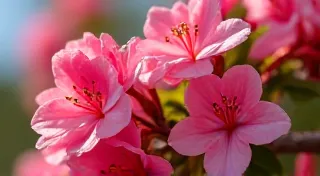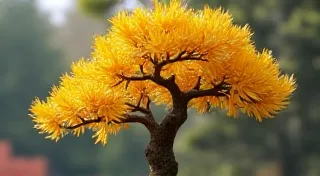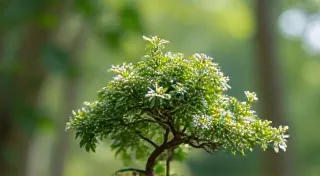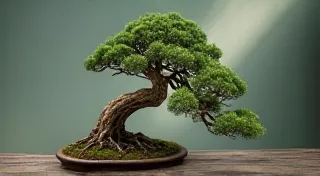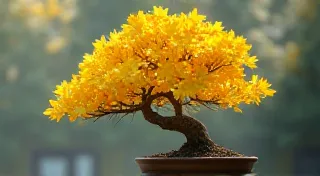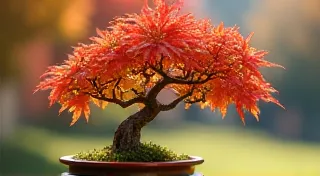Azalea Bonsai: A Guide to Vibrant Blooms
Azaleas are a hugely popular choice for bonsai enthusiasts, and for good reason! Their vibrant, profuse blooms offer a stunning display of color, transforming a bonsai into a true showstopper. However, cultivating a thriving and flowering Azalea bonsai requires understanding their specific needs. This guide will provide detailed information on how to care for your Azalea bonsai, from proper planting and watering to pruning and repotting, ensuring maximum flowering and healthy growth.
Understanding Azalea Bonsai
Before diving into the care instructions, it's essential to understand a few key aspects of Azaleas. They are acid-loving plants, meaning they thrive in soil with a low pH. They also prefer bright, indirect light and consistent moisture. There are many different varieties of Azaleas suitable for bonsai, including Satsuki and Kurume types, each offering unique bloom colors and characteristics. Choosing the right species is just the first step; understanding the underlying principles of bonsai care, often involving a delicate balance of elements, mirrors the care required for larger trees. You can find a fascinating look at the unseen architecture of bonsai, particularly concerning root systems, in a related article about The Silent Dialogue: Root Systems and the Unseen Architecture. This deeper understanding can enhance your overall bonsai success.

Planting and Soil
The right soil mix is crucial for healthy Azalea bonsai. A standard bonsai soil mix often isn't ideal, as Azaleas demand acidity. A recommended mix consists of:
- Peat moss: Provides acidity and moisture retention.
- Perlite: Improves drainage and aeration.
- Akadama: Provides nutrients and aids in water retention.
When planting a new Azalea bonsai, choose a pot with good drainage holes. Ensure the root ball is gently loosened before placing it in the new pot. Backfill with your prepared soil mix, gently tamping down to eliminate air pockets. The careful selection of a container is as important as the soil itself; a container that allows for proper drainage and aeration is paramount for a healthy root system.
Watering and Humidity
Azaleas need consistent moisture, but avoid overwatering. The frequency of watering will depend on the climate, pot size, and time of year. Check the soil surface regularly – if it feels dry to the touch, it’s time to water. Water thoroughly until water drains from the drainage holes. Consistent moisture levels are vital, and different species of trees have different needs – something you might also find useful when considering other bonsai varieties, such as a classic Boxwood Bonsai for its enduring appeal.
Azaleas also benefit from increased humidity, especially during dry periods. You can mist your bonsai regularly, place a humidity tray filled with pebbles and water near the tree, or use a humidifier.
Light and Location
Azalea bonsai thrive in bright, indirect sunlight. Avoid exposing them to harsh, direct sunlight, especially during the hottest part of the day, as this can scorch the leaves. An east or west-facing window is often ideal. In hotter climates, shade cloth can be used to reduce intense sunlight.
Pruning for Shape and Blooms
Pruning is essential for maintaining the desired shape of your Azalea bonsai and encouraging flowering. There are two main types of pruning: structural pruning and maintenance pruning.
- Structural Pruning: Done during the dormant season (late winter or early spring), this involves removing larger branches to establish the overall shape and design.
- Maintenance Pruning: Carried out throughout the growing season, this involves pinching back new growth to maintain the shape and encourage branching.
Important: Azaleas bloom on old wood, so avoid pruning the branches that produced flowers the previous year unless absolutely necessary. Understanding how a tree directs its energy is key, and this applies across species. You can achieve similar aesthetic goals with other trees, such as a majestic Hinoki Cypress Bonsai, known for its elegant form.
Repotting Your Azalea Bonsai
Repotting is necessary to refresh the soil and prune the roots. Younger Azalea bonsai should be repotted every 1-2 years, while older trees can be repotted every 3-5 years. The best time to repot is in early spring, just before the growing season begins.
When repotting, gently remove the bonsai from its pot, carefully untangle the roots, and prune back about one-third of the root mass. Use fresh bonsai soil and ensure good drainage. The success of repotting, like other bonsai practices, involves a thoughtful approach that respects the tree’s natural rhythms and health.
Fertilizing for Vibrant Blooms
Azaleas benefit from regular fertilization during the growing season. Use a balanced, acid-loving fertilizer diluted to half strength. Fertilize every 2-4 weeks during spring and summer, and reduce or stop fertilizing during the dormant season. Maintaining a balanced ecosystem around the tree is fundamental, much like it is for any landscape.

Common Problems and Solutions
- Yellowing Leaves: Could be caused by overwatering, underwatering, or nutrient deficiencies. Adjust watering practices and fertilize accordingly.
- Leaf Drop: Often a sign of stress, which can be caused by sudden changes in temperature or light.
- Pests: Azaleas can be susceptible to aphids, spider mites, and scale. Regularly inspect your bonsai and treat infestations promptly with insecticidal soap or neem oil.
Dealing with common ailments is an important aspect of bonsai care, mirroring the challenges faced by arborists and horticulturalists in managing larger trees. Building a robust defense against pests and diseases is crucial for the long-term health of your bonsai, contributing to its beauty and longevity.

Beyond Azaleas: Cultivating Strength and Character
The principles of bonsai extend far beyond the care of Azaleas. The dedication, patience, and understanding of nature’s rhythms required for cultivating these miniature masterpieces are universally applicable to all tree species. If you're captivated by the art of bonsai, consider expanding your knowledge and exploring the cultivation of other species, each with its unique charm and challenges. The strength and character achievable with trees like an Oak Bonsai offer a testament to the power of patient artistry.
Conclusion
Cultivating a thriving and flowering Azalea bonsai requires dedication and attention to detail. By understanding their specific needs and following these guidelines, you can enjoy the beauty and rewards of owning this stunning bonsai species. With proper care, your Azalea bonsai will reward you with years of vibrant blooms and elegant form. The journey of bonsai is a continuous learning process, a connection to nature, and a pathway to appreciating the beauty and resilience of the natural world.
